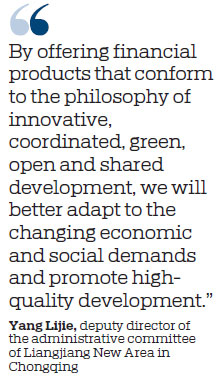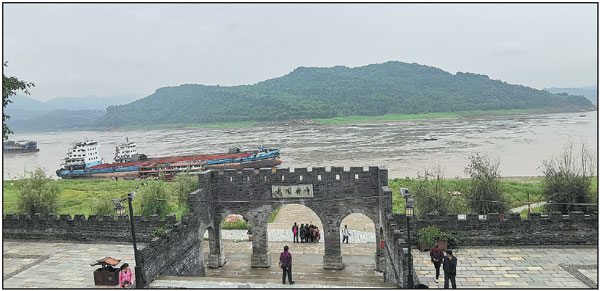Banks embrace green growth
Jiang Xueqing in Chongqing
Updated:2019-06-26
China Daily
Energy conservation, environmental protection sector offers huge potential
Policymakers and bankers are seeing huge market potential for the energy conservation and environmental protection industry, an emerging industry in China. To meet the demands of industrial upgrading for green growth, they emphasized that financial institutions should develop green finance under marketization principles to achieve commercial sustainability.
"Developing green finance is an essential element of China's supply-side structural reform in the financial sector. By offering financial products that conform to the philosophy of innovative, coordinated, green, open and shared development, we will better adapt to the changing economic and social demands and promote high-quality development," said Yang Lijie, deputy director of the administrative committee of Liangjiang New Area in Chongqing, a major city in Southwest China.
He noted that Chongqing is facing downward economic pressure as traditional growth drivers such as the automotive industry have seen a decline in growth since last year.
|
A view of the flood control dam in Mudong town on the south bank of the Yangtze River in Chongqing. The construction and greening of the dam, which is also part of a tourist attraction, are supported by loans from the Chongqing branch of Industrial Bank Co Ltd. Li Lan / For China Daily |
"Fighting with our backs to the wall, we will make greater efforts toward industrial upgrading and economic transition to turn a negative situation into a positive one," he said.
In Chongqing, the annual operating income for the energy conservation and environmental protection industry exceeded 90 billion yuan ($13.1 billion) in 2018, up for four consecutive years at an annual compound growth rate of more than 20 percent.
"We hope that the environmental protection industry will become a supporting industry in Chongqing, which will contribute about 6 percent of the city's gross domestic product," said Zhang Yong, president of the Chongqing Association of Environmental Protection Industry.
Financial institutions have played an irreplaceable role in financing environmental protection projects, in which only a small amount of investment came from the government.
"Providing loans and other types of financing for companies and projects that focus on energy conservation and environmental protection does not mean we are carrying out corporate social responsibility programs with lofty sentiments. Actually, we can make profits from green finance, especially when the companies and projects we support concentrate on sewage treatment or green transportation," said Luo Shiyi, general manager of the green finance department of Industrial Bank Co Ltd, a Fuzhou-headquartered national joint-stock commercial lender.
To make this type of business profitable, green finance professionals at the bank also tried hard to raise low-cost, medium and long-term funding through green bond issuance and other measures.
As the first bank in China that announced the adoption of the Equator Principles, a voluntary set of guidelines in the financial industry to determine, assess and manage environmental and social risks in project financing, Industrial Bank Co Ltd, abbreviated as CIB, has developed green finance into an essential feature of its business.
At the end of March, the bank had offered green financing totaling 1.86 trillion yuan to 17,636 companies and its outstanding green financing was 886.1 billion yuan.
It is estimated that the projects supported by CIB will save 29.84 million metric tons of standard coal and 409.9 million tons of water a year. They will also cut the annual carbon dioxide emissions by 84.22 million tons. This is equivalent to closing 193 100-megawatt coal-fired power plants or stopping 100,000 taxis from running for 40 years, said Luo.

The bank has seen a rise in comprehensive income by developing green finance, although its green lending rates are slightly lower than the rates for other corporate and project loans, said Miao Chunyue, deputy general manager of the green finance department at the Chengdu branch of CIB.
"Sewage treatment companies and gas companies make and receive regular payments, and we provide them with settlement services. While the money flows in and out, a certain amount of funds will stay in their accounts, thus improving our overall income," Miao said.
"Besides, as we deepen our cooperation with these clients, we will dig into their financing needs and find business opportunities through constant contact. For instance, we served as the lead underwriter for a few environmental protection industry leaders in Sichuan province during their issuance of bonds, which brought us intermediate business income to make up for our small profits earned from green finance," she added.
The nonperforming loan ratio of green lending at CIB was roughly one-fourth of the NPL ratio of this type of business for commercial banks in China.
"The key to keeping the NPL ratio low is to maintain strict standards on loan granting based on professional judgments of a sector, a client and a project. Every year, we have guidelines on which industry segment we should participate in. We also take various measures including the adoption of big data and artificial intelligence technologies to identify environmental, social and credit risks," said Luo.
The People's Bank of China, the central bank, is accelerating green finance reforms to further promote the green development of the Yangtze River Economic Belt.
Chongqing and Chengdu are both seeking approval from the central government to participate in the second round of a pilot program for green finance reform and innovation.
"Having formed an initial plan for supporting Chongqing in developing a pilot zone for green finance reform and innovation, we will further clarify our priorities and improve policies and measures as soon as possible," said Li You, deputy director of the PBOC's operations office in Chongqing.
"We will create a favorable policy environment for the development of green finance in Chongqing by striving for the use of monetary policy instruments such as pledged supplementary lending and medium-term lending facilities. Besides, we will support entities and companies in the city to issue green bonds both onshore and offshore, "he said.
The operations office will push ahead with the construction of a big data platform that will give banks access to the information collected by the government on companies along the Yangtze River Economic Belt, to facilitate the offering of comprehensive green financial products and services. It will also set the assessment criteria for green projects and green companies and make recommendations to banks accordingly.
On March 6, China released its new Green Industry Guidance Catalogue to clarify the definition of "green industry" and harmonize different standards for sustainability.
"The catalog is quite helpful for us, by creating a framework that clarifies boundaries of green industry. As far as we know, the policymakers are working to refine the indicators for the catalog and will roll out detailed standards, "said Miao with the Chengdu branch of CIB.
jiangxueqing@chinadaily.com.cn
Video

John Edwards, the UK trade commissioner for China, praised Chongqing over its rise as a burgeoning center in intelligent manufacturing.






